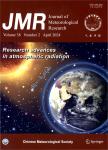Understanding Differences in Event Attribution Results Arising from Modeling Strategy
Understanding Differences in Event Attribution Results Arising from Modeling Strategy作者机构:State Key Laboratory of Numerical Modeling for Atmospheric Sciences and Geophysical Fluid DynamicsInstitute of Atmospheric PhysicsChinese Academy of SciencesBeijing 100029 University of Chinese Academy of SciencesBeijing 100049
出 版 物:《Journal of Meteorological Research》 (气象学报(英文版))
年 卷 期:2022年第36卷第1期
页 面:49-60页
核心收录:
基 金:Supported by the National Key Research and Development Program of China(2018YFC1507701)。
主 题:event attribution anthropogenic influence uncertainty modeling strategy
摘 要:While there is high confidence that human activities have increased the likelihood and severity of hot extreme events over many parts of the world,there is notable spread in quantitative estimates of anthropogenic influence even on a single event.To better understand the uncertainty of attribution results,here we compare different event attribution methods using the 2015 July-August record-breaking heat event in northwestern China as a case study.To address the anthropogenic influence on the likelihood of the extreme event,we employ attribution runs with two modeling strategies—atmosphere-only and coupled simulations—with different conditioning.In atmosphere-only attribution runs,given the observed sea surface boundary conditions and external forcings in 2015,it is estimated that anthropogenic forcing has increased the likelihood of hot extremes such as that observed in 2015 in the target region,by approximately 27 and 12 times in MIROC5 and HadGEM3-A-N216,respectively.In Coupled Model Intercomparison Project phase 5(CMIP5)fully coupled attribution runs,given the external forcing at the 1961-2015 level and regardless of sea surface boundary conditions,there is a 21-fold increase in the likelihood of similar heat events due to anthropogenic forcing.The differences in quantitative attribution results can arise from modeling strategies,which are tightly linked to different conditioning in attribution.Specifically,different ocean boundary conditions,external forcings,and air-sea coupling processes contribute to different attribution results between the two modeling strategies.Within each modeling strategy,model uncertainty affects quantitative attribution conclusions.The comparison of different attribution methods provides a better understanding of the uncertainty of attribution results,which is useful in synthesizing and interpreting attribution results.



